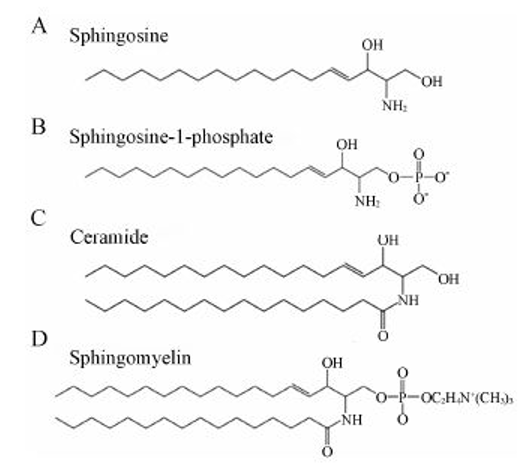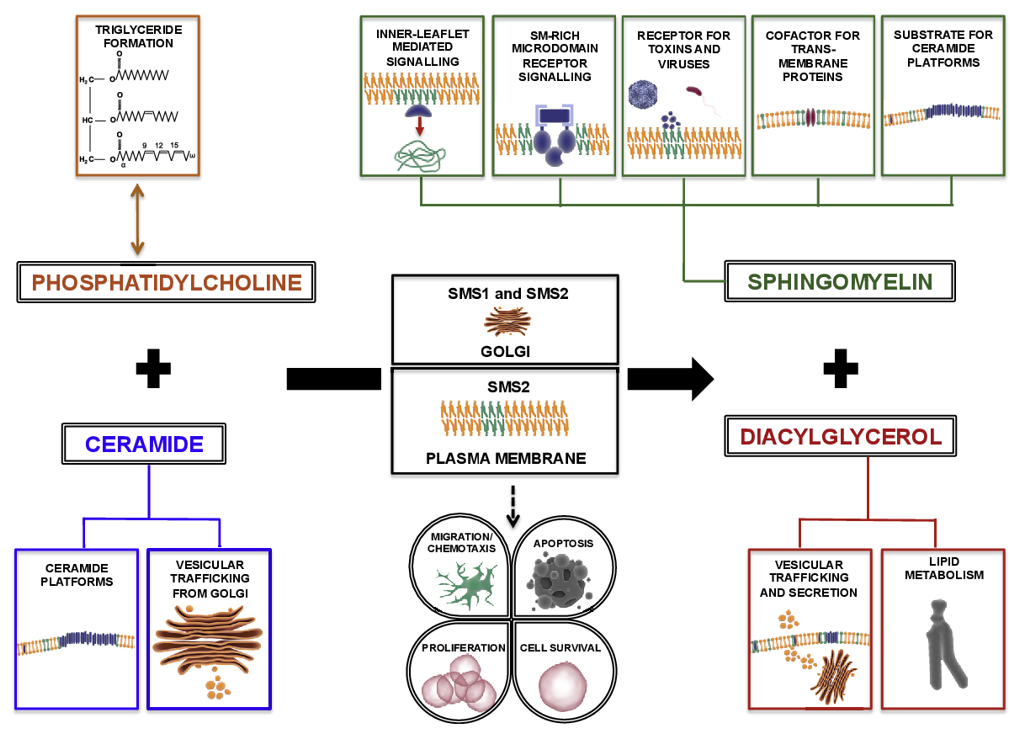Sphingomyelin is the most abundant complex sphingolipid in human cells, and it is an amphoteric lipid composed of sphingosine, fatty acid, and phosphorylcholine. Sphingosine is the basic structural skeleton of all sphingolipids including sphingomyelin. Saturated or monounsaturated fatty acid derivatives are connected to the backbone to form ceramides. Usually, the carbon chain length of these fatty acids is between 14 and 26 carbon atoms. Ceramides with carbon chain lengths greater than 26 carbon atoms are also present on the surface of special skin. Ceramide is further modified to connect a phosphocholine head to form sphingomyelin.

Figure 1. Structure of key sphingolipid molecules
Sphingomyelin is a natural ingredient in food. In recent years, people pay more attention to sphingomyelin in food. The main reason is that it is closely related to diseases caused by cholesterol, fatty acids and mycotoxins in the human body. Therefore, the relationship between sphingomyelin in food and human health has become a feature of current research. The metabolic pathway of sphingomyelin in the human body is not very clear, but studies have shown that its two major metabolites, ceramide and sphingosine, participate in physiological activities such as cell growth, differentiation, and apoptosis in the body.
Most foods contain sphingomyelin, but the content of sphingomyelin in different foods varies greatly. The content of sphingomyelin in fruits and some vegetables is less than 100μmol/kg, and in eggs, dairy products and soy foods, it is as high as 2000 μmol/kg. The content of Sphingomyelin in food can be determined by two types of methods. One is direct determination, such as high-performance liquid chromatography (HPLC) and gas chromatography (GC). Another method is through indirect measurement, such as the determination of sphingomyelin phosphorus content, hexose content in ceramide, or lipid and nitrogen content to estimate the content of sphingomyelin.
The biological function of sphingomyelin
Sphingomyelin is mainly located on cell membranes, lipoproteins (especially LDL) and other lipid-rich tissue structures. Sphingomyelin is very important for maintaining cell membrane structure, especially the micro-control function of the cell membrane (such as membrane invagination). It can regulate the activities of growth factor receptors and supercellular matrix proteins, and provide binding sites for some microorganisms, microbial toxins, and viruses. Many extracellular drugs and external stimuli such as tumor necrosis factor (TNFσ), interleukin (IL-1), gamma radiation, interferon (IFNγ), etc., can hydrolyze sphingomyelin and release ceramide by activating sphingomyelinase. As a second messenger, ceramide can regulate the activity of several substances: the isoenzyme of protein kinase C (PKCζ), protein phosphatase (CAPP) and protein kinase (CAPK).
They act as intracellular factors to activate NF-κB, regulate c-myc expression, induce cyclooxygenase (CoX) and inhibit phospholipid D. Ceramide end effects exhibit different biochemical activities for different cell types and are regulated by other channels, such as PKC channels, where cells exhibit cell differentiation, cell cycle arrest, and apoptosis. In contrast, for platelet-derived growth factor (PDGF) and serum factor-stimulated cells, sphingosine 1-phosphate mediates the signal transduction pathway for cell proliferation. Both types of lipid molecules are metabolites of sphingolipids, but the effects are antagonistic, and cell life and death often depend on which one predominates.
Reference
D'Angelo, G., Moorthi, S., & Luberto, C. (2018). Role and function of sphingomyelin biosynthesis in the development of cancer. Advances in cancer research, 140, 61-96.
